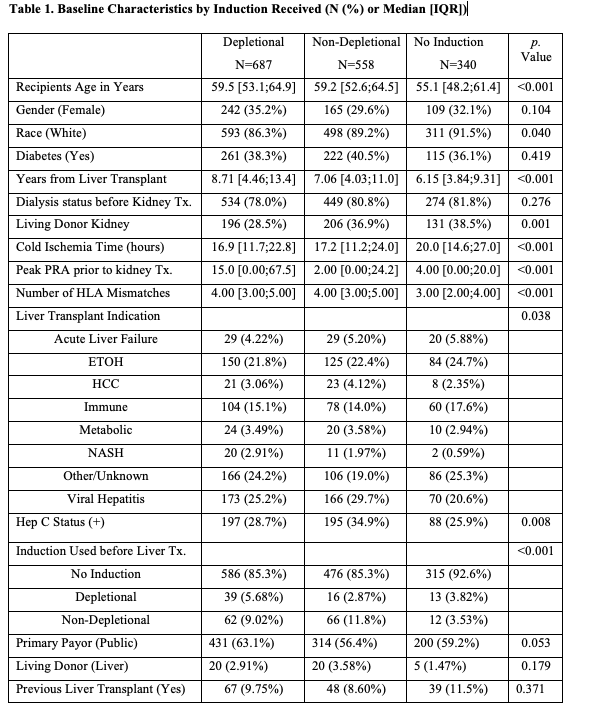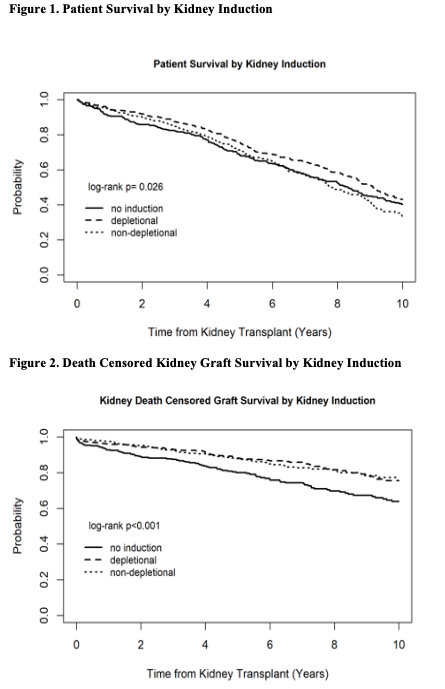Depletional Induction Improves Kidney Graft and Patient Survival in Recipients with a Previous Liver Transplant in the United States
1Medicine, University of Minnesota, Minneapolis, MN, 2Fairview Health Services, Minneapolis, MN, 3Surgery, University of Minnesota, Minneapolis, MN
Meeting: 2020 American Transplant Congress
Abstract number: 257
Keywords: Immunosuppression, Induction therapy, Kidney/liver transplantation, Survival
Session Information
Session Name: Kidney Issues in Liver Transplantation
Session Type: Oral Abstract Session
Date: Saturday, May 30, 2020
Session Time: 3:15pm-4:45pm
 Presentation Time: 3:15pm-3:27pm
Presentation Time: 3:15pm-3:27pm
Location: Virtual
*Purpose: Induction choices for kidney-after-liver transplant recipients are variable. We examined the impact of kidney induction types on kidney graft and patient survival in liver transplant recipients.
*Methods: We utilized the SRTR database through the end of 2015 to study kidney grafts and patients’ outcomes of all kidney-after-liver transplant recipients in the United States. We grouped recipients by induction type into three groups: depletional (N=687), non-depletional (n=558), and no induction (steroid only) (n=340). We studied patients and kidney allografts survival using Cox PH regression, with transplant center included as a random effect. These models were adjusted for kidney and liver induction, recipient and donor age, gender, HLA mismatches, payor type, living kidney, dialysis status, time from liver engraftment, hepatitis C status, DM at time of kidney transplant. Additionally, we analyzed a sub-cohort of recipients only on tacrolimus and mycophenolate maintenance.
*Results: Baseline characteristics are listed in (Table 1). The Kaplan-Meier curves showed statistically significant lower recipients and kidney allografts survival in the no induction group (Figures 1 and 2). Rejection and re-hospitalization rates were not statistically different between groups. In the multivariate model, as compared to no induction, only depletional induction was associated with improved patient survival [HR 0.70, 95% CI (0.53, 0.93), P 0.012] and kidney allograft survival [HR 0.62, 95% CI (0.39, 0.98), P 0.04]. Living-kidney donation was associated with improved kidney survival [HR 0.53, 95% CI (0.34, 0.82), P 0.004]. Results were similar in both cohorts.
*Conclusions: Depletional kidney induction was associated with improved patient and kidney graft survival for those with prior liver transplants. Depletional induction may be the preferred induction for kidney-after-liver transplant recipients.
To cite this abstract in AMA style:
Riad SM, Lim N, Jackson S, Matas A, Lake J. Depletional Induction Improves Kidney Graft and Patient Survival in Recipients with a Previous Liver Transplant in the United States [abstract]. Am J Transplant. 2020; 20 (suppl 3). https://atcmeetingabstracts.com/abstract/depletional-induction-improves-kidney-graft-and-patient-survival-in-recipients-with-a-previous-liver-transplant-in-the-united-states/. Accessed December 14, 2025.« Back to 2020 American Transplant Congress


